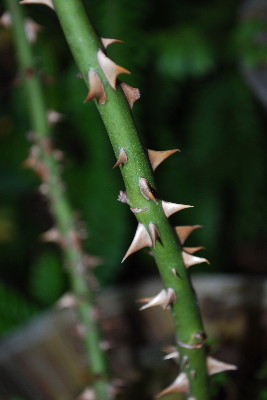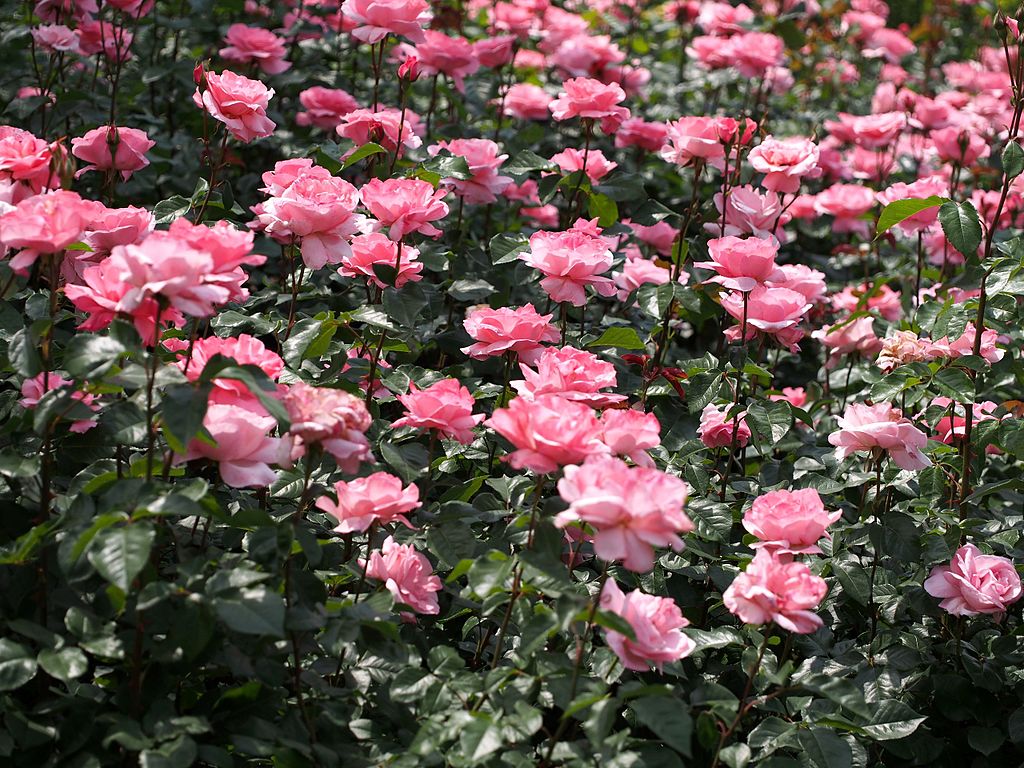When we were first married, my husband would either send or bring me a beautiful bouquet of long stemmed red roses for Valentine’s Day. As much as I loved them, I always felt just a little guilty to have them. We didn’t have a whole lot of money back then,the flowers were expensive and I knew that they wouldn’t last long. Throughout the years, his gifts changed from roses to cards and chocolate. I love chocolate, but this year I am strongly hinting that we go back to long stemmed roses. Instead of a bouquet though, I would love to have a rose garden installed right next to our bedroom window. Imagine waking each day to watch dew glistening on the rose petals and drifting off to sleep every night wrapped in the sweet, subtle fragrance of roses. Lovely.
Roses have the reputation of being temperamental plants, difficult, if not nearly impossible to grow. Many novice gardeners believe that roses are beyond their capabilities. Others insist that roses do not survive in colder climates or in dry, windy regions. Having successfully grown roses in the Flint Hills of Kansas and the rice belt of Arkansas, I am convinced that roses will thrive just about anywhere with the right care. The American Rose Society agrees with me.
Finding a prime location for your rose garden is the first step. In order to thrive, roses need a minimum of six to eight hours of sun each day, with morning sun being preferred over afternoon. They want to be away from large trees and shrubs that act as competition for water and soil nutrients. A lawn’s root system can also act as competition, so creating a designated bed rather than planting directly into a grassy patch is recommended. Avoid placing beds in wind-swept corridors, as rose foliage tends to dry out quickly. Plant near a convenient access to water; roses need regular watering. Finally, make sure that your rose garden is in a spot where you will be able to truly experience and enjoy it every day.
Once the perfect location is determined, then the beds should be prepared. Roses benefit from a rich, well-drained soil that is high in organic matter. Roses simply will not tolerate heavy clay soil or overly sandy soil. Tiling in 2 to 4 inches of organic matter such as aged manure, peat moss or compost can help correct poor soil. Soil testing, often available at garden centers or through the state extension service, can also give valuable information as to which nutrients the soil needs. It’s a good idea to work the ground in advance to allow the soil to settle before roses are planted. Air pockets in the soil can cause problems later. Beds can be worked any time throughout the year that the ground is not frozen, but if you squeeze a handful of soil and water runs out, then it is too wet to work.
Having completed the rather mundane preparatory work, it is time to begin the fun part — selecting the plants themselves. Roses are available in numerous sizes, varieties and grades and can be purchased as either bare root or in containers. Knowing just a bit about each helps you select what works best for you.
The grade of a rose refers to its size and strength. Garden centers usually sell only the top grades of 1 and 1 ½., which is one reason that they tend to be more expensive there. A bargain rose is often a number 2, which is actually a cull from the growing fields. Bargain roses are usually not true bargains, being more susceptible to diseases and insects. (My first venture into roses was what I thought was an amazing bargain. The wilting, sickly yellowing leaves should have been a clue, but I was young and naive and thought that all they needed was to be planted and loved. I bought 10 close-out roses for a dollar a piece at what today is known as a big box store. Looking back I realize that they were not only number 2 grade roses, but I’m sure that they had suffered badly throughout the spring selling season. I proudly planted them in holes that were probably too small, trimmed them, fed them and watched them die off one by one without ever blooming. It was several years before I tried roses again.)

Bare root roses are rose bushes that are still dormant and have no soil around the roots when sold. If possible, check that the canes are green and solid and that the root system is well-balanced and supple. Try to purchase bare root roses in the early spring before they have broken dormancy from warm, indoor conditions. Bare root plants that have remained indoors too long can become weak and may not survive the transition to the garden.
Container roses are available throughout the planting season. Look for vigorous plants in larger containers which work to accommodate root growth. Two gallon containers are the smallest size in which number 1 roses should be potted. Both bare root and potted plants can be the beginning of a beautiful rose bed. Specific planting instructions for your area for both bare root and potted plants should be available at purchase. Your state extension service or the American Rose Society also have excellent planting guides online.

The American Rose Society recognizes over 150 Species of roses today. They range in size from tiny 12 inch miniatures to imposing 16 foot climbers. Some bloom as a single flowers on solid stem and others as clusters that almost seem to weep. Some are known for their strong fragrance while others have outstanding or unusual colors. Some are dramatic, stand alone specimens and others work best in masses. The incredible variety is what makes the rose in all of its forms one of our most treasured garden plants.
With over 150 recognized species, it would be impossible to offer a description of all of them. With Valentine’s Day in mind, I have picked what I feel are the three most commonly known and available rose types. I have grown varieties from each of these classes and have loved them all.
Hybrid Tea
The Hybrid Tea is characterized by its single, large pointed bloom on a long, sturdy stem. The bushes range in height from three to six feet and the blooms can be as much as 5 inches in diameter. They are perfect for cutting and can be stunning as a single bloom or within a bouquet. Hybrid Tea roses do require a bit of coddling in the garden, but are worth the effort.
Grandiflora

Grandiflora roses live up to their name in terms of both their height and blooms. Most grandiflora bushes range from six to eight feet tall, although I have seen varieties reach nearly ten feet tall. They bloom as both a single flower and in clusters of five to seven blooms. Excellent to cut for bouquets, grandiflora blooms are quite long-lasting. They are especially striking in masses and are much less particular than Hybrid Teas.
Florabunda
Next to the Hybrid Tea rose, the florabunda is probably the most well-recognized and well-loved garden rose. Its ability to produce an abundance of clustered flowers on a stocky three to four foot bush make it a perfect choice for a small space. Floribunda roses are typically very hardy and disease resistant, making them the perfect choice for the novice rose grower.
Americans are projected to spend over 2 billion dollars on flowers for Valentine’s Day in 2018. The vast majority of those will be long-stemmed red roses, which in the language of flowers, symbolizes true love. My suggestion is to give your true love not just one bouquet of red roses on Valentine’s Day, but a garden full of rose bouquets for years to come.






